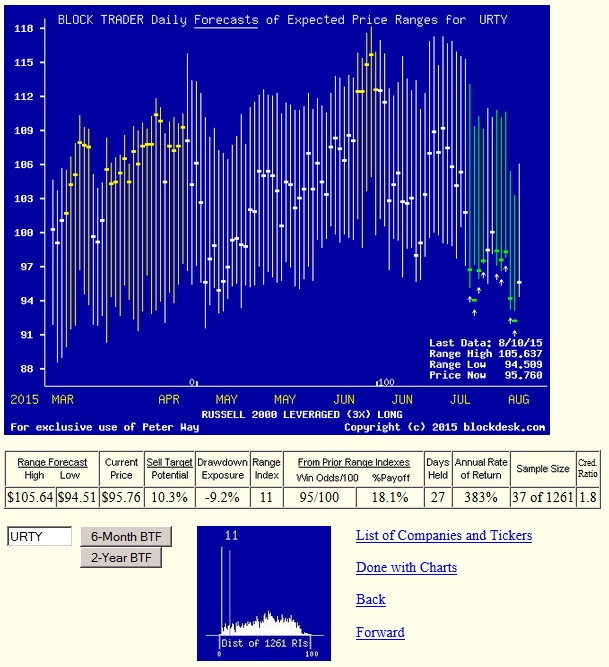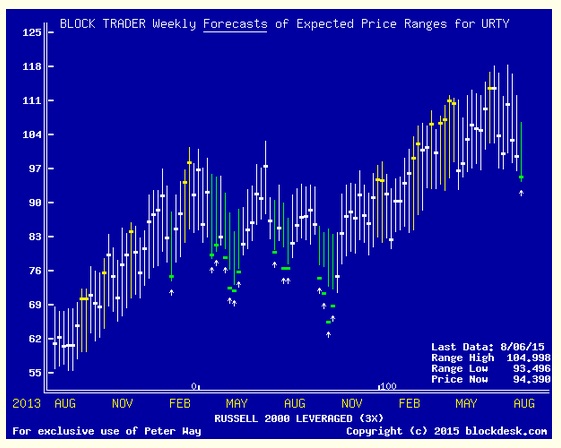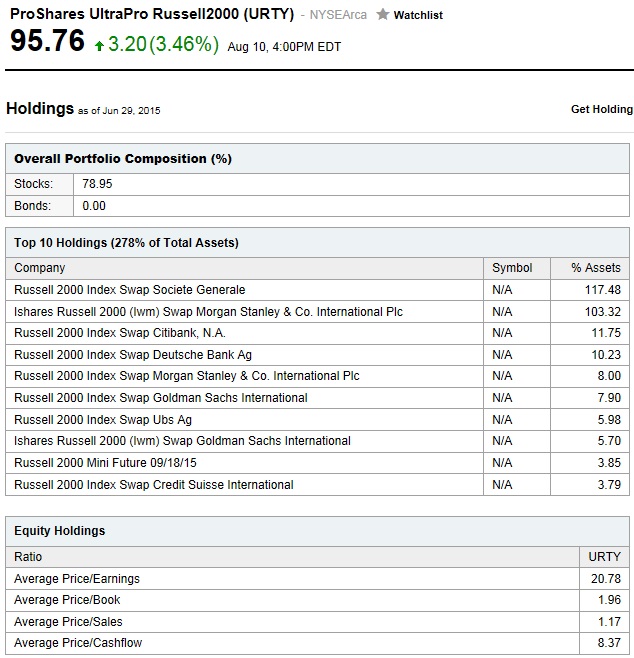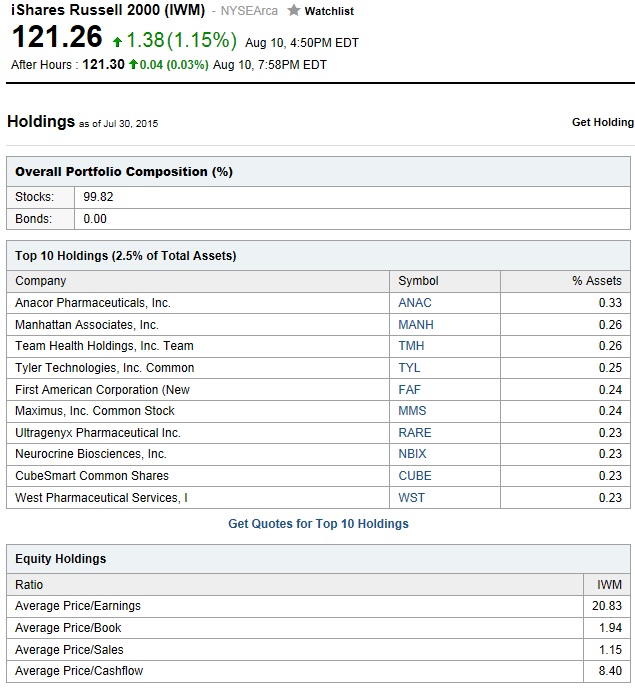Scalper1 News




 Summary From a population of some 350 actively-traded, substantial, and growing ETFs this is a currently attractive addition to a portfolio whose principal objective is wealth accumulation by active investing. We daily evaluate future near-term price gain prospects for quality, market-seasoned ETFs, based on the expectations of market-makers [MMs], drawing on their insights from client order-flows. The analysis of our subject ETF’s price prospects is reinforced by parallel MM forecasts for each of the ETF’s ten largest holdings. Qualitative appraisals of the forecasts are derived from how well the MMs have foreseen subsequent price behaviors following prior forecasts similar to today’s. Size of prospective gains, odds of winning transactions, worst-case price drawdowns, and marketability measures are all taken into account. Today’s most attractive ETF Is the ProShares UltraPro Russell2000 ETF (NYSEARCA: URTY ). The investment seeks daily investment results that correspond to three times (3x) the daily performance of the Russell 2000® Index. The fund invests in securities and derivatives that ProShare Advisors believes, in combination, should have similar daily return characteristics as three times (3x) the daily return of the index. The index is a float-adjusted, market capitalization-weighted index containing approximately 2000 of the smallest companies in the Russell 3000® Index or approximately 8% of the total market capitalization of the Russell 3000® Index, which in turn represents approximately 98% of the investable U.S. equity market. It is non-diversified. The fund currently holds assets of $79.94 million and has had a YTD price return of +6.57%. Its average daily trading volume of 140,328 produces a complete asset turnover calculation in 5.9 days at its current price of $95.76. Behavioral analysis of market-maker hedging actions while providing market liquidity for volume block trades in the ETF by interested major investment funds has produced the recent past (6 month) daily history of implied price range forecasts pictured in Figure 1. Figure 1 (used with permission) The vertical lines of Figure 1 are a visual history of forward-looking expectations of coming prices for the subject ETF. They are NOT a backward-in-time look at actual daily price ranges, but the heavy dot in each range is the ending market quote of the day the forecast was made. What is important in the picture is the balance of upside prospects in comparison to downside concerns. That ratio is expressed in the Range Index [RI], whose number tells what percentage of the whole forecast range lies below the then current price. Today’s Range Index is used to evaluate how well prior forecasts of similar RIs for this ETF have previously worked out. The size of that historic sample is given near the right-hand end of the data line below the picture. The small blue thumbnail distribution at the bottom of Figure 1 indicates the current RI’s size in relation to all available RIs of the past 5 years. The first items in the data line are current information: The current high and low of the forecast range, and the percent change from the market quote to the top of the range, as a sell target. The Range Index is of the current forecast. Other items of data are all derived from the history of prior forecasts. They stem from applying a T ime- E fficient R isk M anagement D iscipline to hypothetical holdings initiated by the MM forecasts. That discipline requires a next-day closing price cost position be held no longer than 63 market days (3 months) unless first encountered by a market close equal to or above the sell target. The net payoffs are the cumulative average simple percent gains of all such forecast positions, including losses. Days held are average market rather than calendar days held in the sample positions. Drawdown exposure indicates the typical worst-case price experience during those holding periods. Win odds tells what percentage proportion of the sample recovered from the drawdowns to produce a gain. The cred(ibility) ratio compares the sell target prospect with the historic net payoff experiences. Figure 2 provides a longer-time perspective by drawing a once-a week look from the Figure 1 source forecasts, back over two years. Figure 2 (used with permission) What does this ETF hold, causing such price expectations? Figure 3 is a table of securities held by the subject ETF, indicating its concentration in the top ten largest holdings, and their percentage of the ETF’s total value. Figure 3 source: Yahoo Finance URTY holdings reveal how an average of assets in each of its top ten commitments, all swap contracts in either the Russell 2000 index or the ETF tracking that index, iShares Russell 2000 (NYSEARCA: IWM ) provide a 3x leverage to the price movements of that small-cap index. Please note that the top ten swap contracts equal 278% of the ETF’s total assets. To have an idea of the composition of the Russell 2000 index, Figure 4 is a table of data lines similar to that contained in Figure 3, for each of the top ten holdings of the ETF tracking the Russell 2000 index, IWM. Figure 4 source: Yahoo Finance Now note that the Russell 2000 index does indeed contain 2,000 securities of small-capitalization companies, many of which are in quite volatile circumstances. The IWM’s top ten holdings (by size of holding) quite probably are intended to be the better-performing issues. While these ten represent only 2 ½% of the fund’s total assets, they are five times the size of ten average pieces of 2,000 securities at 0.05% of the total. The IWM’s top ten holdings provide only a peek at the kinds of companies contained in the Russell 2000 index, but it is better than nothing (or of everything). In order to fill out some sense of these emphasized holdings of the fund and the index, Figure 5 gives the details of MM price range hedging-derived forecasts for each of the ten, and compares them with data from our ranked top20 securities list for the same day. Figure 5 (click to enlarge) In an index as unpredictably dynamic as this, wide variations in market experience seem to be the rule. Column (5) contains the upside price change forecasts between current market prices and the upper limit of prices regarded by MMs as being worth paying for price change protection. The average of +12.7% of the top ten IWM/index holdings is close to our list’s population average of all 2500+ equities MM forecasts of +13.1%. It is about 2 ½ times the upside forecast for SPY price change prospects. The other side of the coin is column (6), which shows what actual worst-case price drawdowns typically have been in the 3 months following each time there has been a forecast like those of the present day. Those risk exposures have averaged -6.3% in the holdings top ten, better than -8.6% experienced by list equities at large, but larger than the only -3.3% on the SPY ETF. These holdings have attractive reward tradeoffs between returns and risks, with the top ten (column 14) at a ratio of 2.0, compared to equities overall at 1.5 times. This is better than the market average of SPY at a ratio of 1.7 times risk avoidance, which has a cost of an anticipated reward (column 5) only half that of the ten best index stocks. Another qualitative consideration is the credibility of the ten IWM/index big holdings after previous forecasts like today’s. The net average price change (column 13) of the ten has been 0.8 times the size of the (column 5) upside forecast average, +10.6% (column 9) compared to +12.7%. The equity population’s actual price gain achievement, net of losses has been a pitiful +3.7% compared to promises of 13.1%. The ability of IWM/index holdings to recover from those worst-case drawdowns and achieve profits occurred in 83% of experiences (column 8). The equity population only recovered less than two thirds of the time, and while the SPY experiences were about the same as the ten IWM/index holdings, the achieved gains were much smaller. SPY has had only +3.4% gains previously from like forecasts of +5.7%. In many respects the IWM/index holdings are quite similar to the average of our daily best20 list. That should be no surprise, since URTY is one of those 20 best ranked issues on this day. Conclusion URTY provides attractive forecast price gains, supported by its equally appealing largest holdings. Both the ETF and many of its major holdings offer very attractive prospects in near-term price behaviors, demonstrated by previous experiences following prior similar forecasts by market makers. The diversity of its holdings is very broad, providing a wide opportunity to share in constantly developing discoveries across the biotechnology as well as software applications and other high-technology fields. URTY’s price now, in comparison to the forecast price expectations of market professionals, appears to be quite attractive. Disclosure: I/we have no positions in any stocks mentioned, and no plans to initiate any positions within the next 72 hours. (More…) I wrote this article myself, and it expresses my own opinions. I am not receiving compensation for it (other than from Seeking Alpha). I have no business relationship with any company whose stock is mentioned in this article. Scalper1 News
Summary From a population of some 350 actively-traded, substantial, and growing ETFs this is a currently attractive addition to a portfolio whose principal objective is wealth accumulation by active investing. We daily evaluate future near-term price gain prospects for quality, market-seasoned ETFs, based on the expectations of market-makers [MMs], drawing on their insights from client order-flows. The analysis of our subject ETF’s price prospects is reinforced by parallel MM forecasts for each of the ETF’s ten largest holdings. Qualitative appraisals of the forecasts are derived from how well the MMs have foreseen subsequent price behaviors following prior forecasts similar to today’s. Size of prospective gains, odds of winning transactions, worst-case price drawdowns, and marketability measures are all taken into account. Today’s most attractive ETF Is the ProShares UltraPro Russell2000 ETF (NYSEARCA: URTY ). The investment seeks daily investment results that correspond to three times (3x) the daily performance of the Russell 2000® Index. The fund invests in securities and derivatives that ProShare Advisors believes, in combination, should have similar daily return characteristics as three times (3x) the daily return of the index. The index is a float-adjusted, market capitalization-weighted index containing approximately 2000 of the smallest companies in the Russell 3000® Index or approximately 8% of the total market capitalization of the Russell 3000® Index, which in turn represents approximately 98% of the investable U.S. equity market. It is non-diversified. The fund currently holds assets of $79.94 million and has had a YTD price return of +6.57%. Its average daily trading volume of 140,328 produces a complete asset turnover calculation in 5.9 days at its current price of $95.76. Behavioral analysis of market-maker hedging actions while providing market liquidity for volume block trades in the ETF by interested major investment funds has produced the recent past (6 month) daily history of implied price range forecasts pictured in Figure 1. Figure 1 (used with permission) The vertical lines of Figure 1 are a visual history of forward-looking expectations of coming prices for the subject ETF. They are NOT a backward-in-time look at actual daily price ranges, but the heavy dot in each range is the ending market quote of the day the forecast was made. What is important in the picture is the balance of upside prospects in comparison to downside concerns. That ratio is expressed in the Range Index [RI], whose number tells what percentage of the whole forecast range lies below the then current price. Today’s Range Index is used to evaluate how well prior forecasts of similar RIs for this ETF have previously worked out. The size of that historic sample is given near the right-hand end of the data line below the picture. The small blue thumbnail distribution at the bottom of Figure 1 indicates the current RI’s size in relation to all available RIs of the past 5 years. The first items in the data line are current information: The current high and low of the forecast range, and the percent change from the market quote to the top of the range, as a sell target. The Range Index is of the current forecast. Other items of data are all derived from the history of prior forecasts. They stem from applying a T ime- E fficient R isk M anagement D iscipline to hypothetical holdings initiated by the MM forecasts. That discipline requires a next-day closing price cost position be held no longer than 63 market days (3 months) unless first encountered by a market close equal to or above the sell target. The net payoffs are the cumulative average simple percent gains of all such forecast positions, including losses. Days held are average market rather than calendar days held in the sample positions. Drawdown exposure indicates the typical worst-case price experience during those holding periods. Win odds tells what percentage proportion of the sample recovered from the drawdowns to produce a gain. The cred(ibility) ratio compares the sell target prospect with the historic net payoff experiences. Figure 2 provides a longer-time perspective by drawing a once-a week look from the Figure 1 source forecasts, back over two years. Figure 2 (used with permission) What does this ETF hold, causing such price expectations? Figure 3 is a table of securities held by the subject ETF, indicating its concentration in the top ten largest holdings, and their percentage of the ETF’s total value. Figure 3 source: Yahoo Finance URTY holdings reveal how an average of assets in each of its top ten commitments, all swap contracts in either the Russell 2000 index or the ETF tracking that index, iShares Russell 2000 (NYSEARCA: IWM ) provide a 3x leverage to the price movements of that small-cap index. Please note that the top ten swap contracts equal 278% of the ETF’s total assets. To have an idea of the composition of the Russell 2000 index, Figure 4 is a table of data lines similar to that contained in Figure 3, for each of the top ten holdings of the ETF tracking the Russell 2000 index, IWM. Figure 4 source: Yahoo Finance Now note that the Russell 2000 index does indeed contain 2,000 securities of small-capitalization companies, many of which are in quite volatile circumstances. The IWM’s top ten holdings (by size of holding) quite probably are intended to be the better-performing issues. While these ten represent only 2 ½% of the fund’s total assets, they are five times the size of ten average pieces of 2,000 securities at 0.05% of the total. The IWM’s top ten holdings provide only a peek at the kinds of companies contained in the Russell 2000 index, but it is better than nothing (or of everything). In order to fill out some sense of these emphasized holdings of the fund and the index, Figure 5 gives the details of MM price range hedging-derived forecasts for each of the ten, and compares them with data from our ranked top20 securities list for the same day. Figure 5 (click to enlarge) In an index as unpredictably dynamic as this, wide variations in market experience seem to be the rule. Column (5) contains the upside price change forecasts between current market prices and the upper limit of prices regarded by MMs as being worth paying for price change protection. The average of +12.7% of the top ten IWM/index holdings is close to our list’s population average of all 2500+ equities MM forecasts of +13.1%. It is about 2 ½ times the upside forecast for SPY price change prospects. The other side of the coin is column (6), which shows what actual worst-case price drawdowns typically have been in the 3 months following each time there has been a forecast like those of the present day. Those risk exposures have averaged -6.3% in the holdings top ten, better than -8.6% experienced by list equities at large, but larger than the only -3.3% on the SPY ETF. These holdings have attractive reward tradeoffs between returns and risks, with the top ten (column 14) at a ratio of 2.0, compared to equities overall at 1.5 times. This is better than the market average of SPY at a ratio of 1.7 times risk avoidance, which has a cost of an anticipated reward (column 5) only half that of the ten best index stocks. Another qualitative consideration is the credibility of the ten IWM/index big holdings after previous forecasts like today’s. The net average price change (column 13) of the ten has been 0.8 times the size of the (column 5) upside forecast average, +10.6% (column 9) compared to +12.7%. The equity population’s actual price gain achievement, net of losses has been a pitiful +3.7% compared to promises of 13.1%. The ability of IWM/index holdings to recover from those worst-case drawdowns and achieve profits occurred in 83% of experiences (column 8). The equity population only recovered less than two thirds of the time, and while the SPY experiences were about the same as the ten IWM/index holdings, the achieved gains were much smaller. SPY has had only +3.4% gains previously from like forecasts of +5.7%. In many respects the IWM/index holdings are quite similar to the average of our daily best20 list. That should be no surprise, since URTY is one of those 20 best ranked issues on this day. Conclusion URTY provides attractive forecast price gains, supported by its equally appealing largest holdings. Both the ETF and many of its major holdings offer very attractive prospects in near-term price behaviors, demonstrated by previous experiences following prior similar forecasts by market makers. The diversity of its holdings is very broad, providing a wide opportunity to share in constantly developing discoveries across the biotechnology as well as software applications and other high-technology fields. URTY’s price now, in comparison to the forecast price expectations of market professionals, appears to be quite attractive. Disclosure: I/we have no positions in any stocks mentioned, and no plans to initiate any positions within the next 72 hours. (More…) I wrote this article myself, and it expresses my own opinions. I am not receiving compensation for it (other than from Seeking Alpha). I have no business relationship with any company whose stock is mentioned in this article. Scalper1 News
Scalper1 News